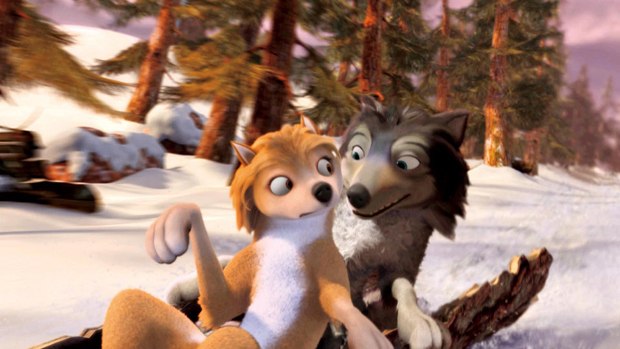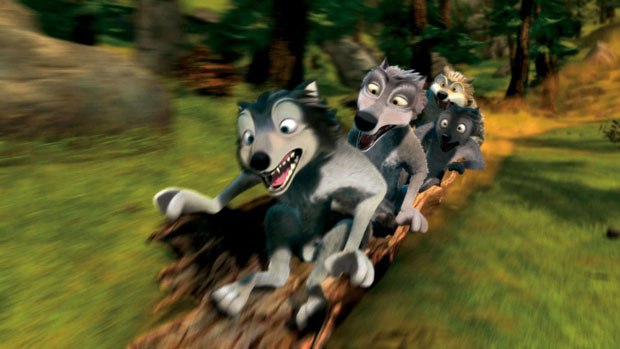One of the directors of the latest Crest Animation/Lionsgate feature discusses tackling CG wolves and 3-D.
Check out the Alpha and Omega trailer and clips at AWNtv!
A different kind of animated road trip from Open Season creator Steve Moore occurs in Alpha and Omega (opening today from Crest Animation/Lionsgate). Here we have a love story between alpha and omega wolves from warring packs: Kate (Hayden Panettiere) is definitely a serious leader, while Humphrey (Justin Long) is more a laid-back sort, but, together, they need to make it back to home after being abducted to Idaho. Director Anthony Bell, a CalArts grad and TV vet (The Boondocks and Rugrats) talks about the challenges of keeping ahead of the curve with CG and 3-D.
Bill Desowitz: What attracted you to Alpha and Omega?
Anthony Bell: The story had heart. I gravitate to projects that speak to me in terms of emotion. It had a social message about differences being our strength instead of our weakness, but it was expressed in a really fun and entertaining way, not preachy, and I thought this was something I've gotta work on.
BD: There's obviously something very African Queen about it.
AB: You nailed it on the head because The African Queen is something that definitely inspired us. We looked at that. In terms of looking at other animated films, we wanted to do something unique so we veered away from copying anything animated.
BD: What informed the look of the characters and the environments?
AB: We wanted to find a style that stood out from the other studios, so we took a graphic approach with the characters themselves. In terms of art direction on the backgrounds, instead of making a fantasy world, we wanted to make a world where people would want to visit because of the beauty. We didn't want something whimsical or abstract. We thought the two would marry together nicely.
BD: What was the animation process like having Crest Animation in India and LA?
AB: Crest Animation in India is our parent company so what's unique about this and what I enjoyed -- especially coming from TV where they send things overseas and it's by the book -- is that it was like working with an extension of the same studio. A lot of thought went into this and if something didn't work, they would flesh it out and make sure it was the best it could be. We'd go over there and spend time with them and go over the nuances of the animation.
BD: Did they do all of the animation in India?
AB: Yes, they would do the physical animation but would send blocking scenes here and we had a small crew here that would go over the blocking and do tweaks and offer suggestions. It was very collaborative.
BD: What kind of a toolset do they have?
AB: We worked with Maya and the environments were a little challenging for us because we wanted a painterly feel, so instead of doing texture mapping, we did some exploratory stuff and created our own programs for that. What we would do is come up with visual styles and they would work out a systematic way of achieving it. Obviously we used a lot of sawtooth mountains in Idaho and Canada for detailing. Short of going there, you could imagine all the reference material we had at our fingertips.
BD: What would you say were the primary animation challenges?
AB: Again, they had to do with the stylistic designs and, anatomically, some of the things didn't quite work with the rigging. So we wanted to get more of a natural, animalistic-type movement in the wolves, which was believable, making sure the gravity worked and that the lands worked. In designing them, everything was a perfect model of a wolf. We caricatured the wolves. And some of the expressions were hard and getting this hair to work and not be just clunky geometry was a challenge. I think the overlapping, the subtlety and nuances of that nature were important so that the facial performances could work without being distracted by this hair.
BD: How did you animate the fur?
AB: We used various tricks: some was simulated; most of it was grown in a manner similar to Shave and a Haircut.
BD: What was the stereoscopic 3-D experience like?
AB: Obviously this was our first stereoscopic movie and all of us grew up on things that come out of the screen. But that's not what we wanted to do, and I know everyone is harping on using 3-D as a story tool and not as a gimmick, and it's true: that's the approach we used with this movie -- we didn't want to distract, we didn't want to do eye candy. We wanted to figure out ways to aid the storytelling sensibilities and use it as another voice.
BD: So how did you use it to aid the story?
AB: We used it to make the audience feel a little claustrophobic or sometimes when a character is trying to be intimidating, but some of the most effective things that we discovered were the things protruding into the frame like the depth.
BD: What are some key moments?
AB: The major arcs in the movie helped us a lot like action scenes, when the characters fall in love, the big conflicts. We used the stereo elements to help flesh out those emotions.
BD: Tell us about your voice talent.
AB: It was amazing: we had Justin Long, Hayden Panettiere, Christina Ricci, the late, great Dennis Hopper and Danny Glover: you can't beat that ensemble. And they brought so much to the movie in terms of what wasn't written on the page -- some of the ad libs. They were very collaborative and supportive in helping these characters become characters.
BD: What was it like collaborating for the first time with your co-director, Ben Gluck?
AB: We divided the film up and Ben would take the lead on certain sequences and I would take the lead on other aspects; and we worked in tandem and just made sure the story flowed. It was a wonderful team.
BD: What was the learning experience like for you, moving forward with your next feature, Norm of the North?
AB: The use of the camera in telling a CG movie, which was liberating and offered a lot more exploration in telling a story with a camera. And it had to be stereoscopic: that was an amazing tool if used in the right way.
Bill Desowitz is senior editor of AWN & VFXWorld.











